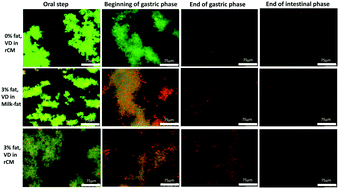Mechanisms of absorption of vitamin D3 delivered in protein nanoparticles in the absence and presence of fat
Abstract
Novel protein-based nanovehicles offer alternatives to fat for delivery of lipophilic bioactives (nutraceuticals and drugs), yet they raise important questions regarding the bioavailability and absorption mechanism of the bioactive without fat. To provide answers, we chose vitamin D3 (VD3) as a model lipophilic-nutraceutical, re-assembled casein-micelles (rCM) as model protein-based nanovehicles, and non-fat yoghurt as a model food. We prepared three yoghurt formulations: 3% fat with VD3 dissolved in milk-fat, non-fat and 3% fat, both latter enriched with VD3 within rCM. Following in vitro digestion, VD3 retention and bioaccessibility were high (∼90% and ∼70%, respectively) in all formulations. VD3 uptake by Caco-2 cells was three-fold higher (p < 0.005) in the non-fat yoghurt enriched with VD3 in rCM compared with enriched fat-containing yoghurts. SR-BI, CD36 and NPC1L1 transporters were involved in VD3 absorption irrespective of the composition. Thus, our findings demonstrate that protein nanovehicles may improve VD3 bioavailability, without altering its absorption mechanism compared to that from fat.



 Please wait while we load your content...
Please wait while we load your content...